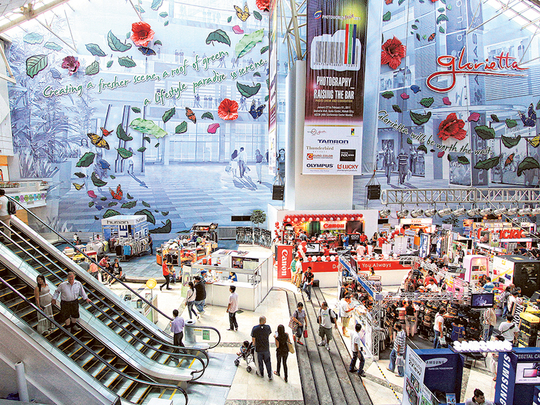
Manila: Philippine builders like SM Prime Holdings Inc. and Ayala Land Inc. can’t add retail space fast enough to satisfy demand from Southeast Asia’s most-confident consumers that pack Manila’s malls.
A record 724,620 square meters (7.8 million square feet) of new retail space will be added in the Philippine capital next year, according to Colliers International. That is a 10th of the existing stock as of the third quarter, according to the real estate broker.
“All of us are looking into adding retail space,” said Teresita Sy-Coson, vice chairman at SM Investments Corp, whose unit SM Prime is the country’s largest mall operator. The retail market is still growing and “we’re all OK with it,” she said.
Rising remittances from Filipinos working and living abroad and a business-process outsourcing boom are fuelling household spending in one of Asia’s fastest-growing economies. Private consumption accounts for at least 60 per cent of the Philippine economy, which is seen expanding by 6 per cent this year and 6.3 per cent in 2016, according to the Asian Development Bank.
Consumer spending remains resilient in an economy that expanded less than analysts estimated in the last quarter from a year earlier. A buying spree during the Christmas holidays can sustain growth at 6 per cent this year, Economic Planning Secretary Arsenio Balisacan has said.
Filipinos were the third-most confident consumers in the world in the third quarter, behind Indians and Americans, according to Nielsen Holdings Plc’s ‘Global Consumer Confidence Index’ report, which uses an online survey of people’s job prospects, personal finances and spending intentions. Consumer sentiment remains positive and buying intentions will be broadly steady next year, according to the latest survey by the Philippine central bank.
SM Prime and Ayala Land are adding retail space to meet the spending habits of shoppers like Jeanne Jampac, a 26-year-old marketing consultant who spends at least $100 (Dh367) on each shopping trip to Ayala Land’s Greenbelt Mall in the Makati business district.
“I know I have a steady income to spend for products that I know I’ll use daily; I think it makes perfect sense,” said Jampac, who on a recent weekly shopping trip spent $150 on makeup from brands Benefit Cosmetics LLC and The FaceShop Ltd.
SM Prime will account for about 28 per cent of Manila’s new mall space next year and Ayala Land about 25 per cent, according to Colliers. Filinvest Land Inc. and Federal Land Inc. will also contribute to the retail space supply in 2016.
Retail sales may increase to $155 billion next year, up 10 per cent year-on-year and the fastest pace since 2010, according to Hamburg-based statistics company Statista Inc.
Consumer demand has prompted Philippine retailer SSI Group Inc to bring Canadian retailer Loblaw Cos’s Joe Fresh fashion brand to Manila next year. That will add to the 190 mid-range and luxury names, such as Hennes & Mauritz AB’s H&M and high-end shoemaker Jimmy Choo Plc, which have entered the Southeast Asian nation since 2008, according to a Cushman & Wakefield Inc report.
“International retailers are coming in or expanding their presence” and additional mall space is allotted for them, said Jan Custodio, Manila-based head of global research and consultancy at CBRE Group Inc.
Manila’s mall boom is happening as developers are slowing residential and office projects to curb speculative investment, according to Colliers.
The average vacancy rate in the capital region’s shopping centres was 0.7 per cent in the third quarter, the lowest since at least the same quarter of 2011, said Julius Guevara, research director at Colliers in Manila. “Barring any unforeseen circumstance, retail space growth can be absorbed by the market,” he said.
Rents in Manila’s malls may rise as much as 5 per cent on average next year compared with projected declines of about 5 per cent each for the capital’s apartment and office leases, according to Colliers.
While there are no signs yet of a let-up in consumer spending, builders “should take into consideration a possible over-expansion, which could be detrimental to their bottom-line,” said Lexter Azurin, research head at Unicapital Securities Inc.
For now, developers aren’t seen hitting the brakes. “Consumerism is still at a high, and there’s a huge spending power,” CBRE’s Custodio said.











